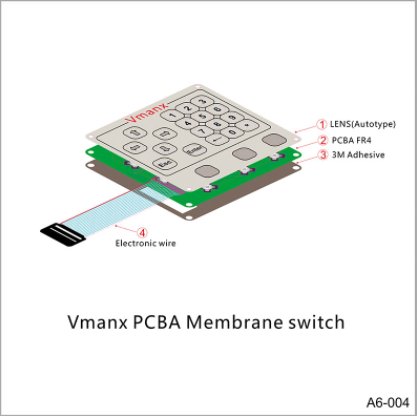 admin
admin  2023-06-13 19:34:51
2023-06-13 19:34:51

A PCB (Printed Circuit Board) membrane switch is a type of interface commonly used in electronic devices and control panels. It combines the functionality of a PCB with a flexible membrane keypad, providing a user-friendly interface for input and control.
Here are some key features and characteristics of a VMANX PCB membrane switch:
Construction: The switch consists of multiple layers. The bottom layer is a PCB that provides the electrical circuitry and connections. On top of the PCB, there is a thin, flexible membrane made of polyester or polycarbonate. The membrane is printed with conductive ink traces and features such as buttons, icons, or text.
Membrane Keypad: The top layer of the switch is the membrane keypad, which includes tactile or non-tactile buttons. Tactile buttons provide a physical feedback when pressed, while non-tactile buttons are flat and do not offer the same tactile sensation.
Electrical Connectivity: The conductive ink traces on the membrane establish electrical connections between the buttons and the PCB. When a button is pressed, it bridges the gap between two conductive traces, completing the circuit and registering the input.
Durability and Flexibility: PCB membrane switches are designed to be durable and withstand repeated use. The flexible membrane can endure millions of actuations without significant wear. The materials used are typically resistant to moisture, dust, and chemicals, ensuring the switch's longevity.
Customization: PCB membrane switches can be customized to fit specific requirements. The design can incorporate various button layouts, shapes, sizes, and colors. Additionally, graphic overlays can be added on top of the membrane to enhance the aesthetics and provide additional information or branding.
Integration: PCB membrane switches are often integrated into a larger electronic assembly or control panel. The PCB portion of the switch can have additional components like LEDs, resistors, or connectors, depending on the specific application.
Applications: PCB membrane switches find application in a wide range of industries, including consumer electronics, medical devices, industrial control panels, automotive systems, telecommunications, and more. They provide an intuitive and reliable interface for user interaction.
When designing or working with PCB membrane switches, it is essential to consider factors such as button placement, actuation force, tactile feedback, environmental conditions, and overall system integration to ensure optimal performance and user experience.